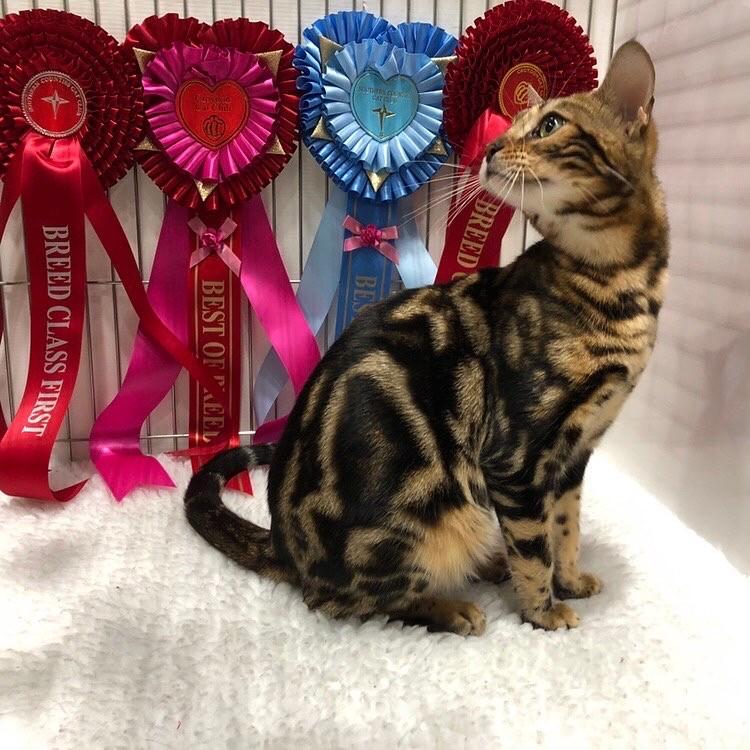The magnificent Marble Bengal
Where do Marble Bengals come from?
It's easy to see why it can be confusing when one thinks about the beautiful, marbled Bengal. If Bengal breeders are breeding to emulate as much as possible the beauty and traits of the wild Asian leopard Cat, then how can there be a Marbled pattern Bengal cat? Since there are no naturally occurring Marbled Asian Leopard Cats, the Marble gene had to have come from some of the domestic cats originally used in the early days of creating the Bengal breed. According to various articles written by Jean Mill, the very first Marbled Bengal appeared in 1987. The parents were Millwood Silk n Cinders (a beautiful cat who had the glitter gene from "Tory of Delhi", Jean's rescue domestic kitten from the New Delhi Zoo, plus Cinders also had an unusually clear, non-ticked coat, with very large, dark spots) and a cat named Torchbearer. This first marble kitten was a female, and her colouring was very soft and rust-coloured, with a pattern described by Jean as looking like "drizzled caramel". Marbled Bengal cats are truly one of a kind. They happened by accident, but what a happy accident it was! The marbled pattern is literally show-stopping. The Marble Bengal is still quite unusual in the UK. Think of them as having huge Rosettes that swirl around all over their bodies, instead of being a traditional mini leopard, they are more like a mini leopard cloud. When they become an adult, the Marbled Bengal is breath-taking and very wild looking. With a silky coat, like touching smooth glass. The behaviour and characteristics are the same as for the Rosetted Bengal, but they can be often a bit larger than a traditional Bengal. All Marble Bengals are unique and individual.
How do you know when you have a top quality marble Bengal?
It seems that each generation of Marble Bengals just keeps getting better. Most breed associations that have a Bengal breed standard do give preference to Marbles that have three or more shades, a background colour, the marble markings, and another colour outlining these markings. This type of Marbled Bengals are often referred to as "Tri-Coloured Marbles". The Marbled pattern develops more slowly than the Spotted pattern and can take up to two years to fully develop. Think of a balloon stretching, so as the kitten grows it also grows into its Marble pattern. All top quality Marbles should have a strong horizontal flow to their patterns, with as little influence from the domestic tabby as possible. Although the Marble pattern itself is derived from the Bengal's domestic ancestors, the appearance of the pattern of a top Bengal Marble is strongly influenced by the wild Asian leopard cat's gene pool, which means horizontal flow, this is especially evident when the cat is stretched. There should be an overall random appearance of the markings. As with the Spotted Bengals, the very best Marble Bengals will have extremely sharp contrast and definition in their markings, with distinct shapes and sharp edges. All Marble Bengals will still have spotted bellies.
Are you convinced you want a Marbled Bengal yet?
Before you buy one, we must briefly discuss what it’s like to own one. Regardless of whether they’re Spotted or Marbled, Bengals have a wild side. They’re descendants of the Asian Leopard Cat, so they need plenty of exercise and mental stimulation. Some owners see the fur colouring and patterns and don’t think too much about how much exercise and mental stimulation a Bengal cat needs. That said, the newer Bengal generations do show a calmer, docile side compared to their ancestors. These cats are now several generations removed from the Asian Leopard Cat, so they don’t require any special care. Still, they’re highly active creatures with an intense desire to explore and hunt. They especially love to climb and need a place to be vertical.
Champion Leopardstar Witch Craft - Retired (Dora)

© Copyright Nevaeh Bengals - Bengal Kittens For Sale